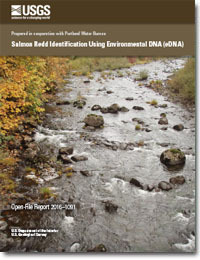Salmon redd identification using environmental DNA (eDNA)
Links
- Document: Report (2 MB pdf)
- Download citation as: RIS | Dublin Core
Introduction
The purpose of this project was to develop a technique to use environmental DNA (eDNA) to distinguish between redds made by Chinook salmon (Oncorhynchus tshawytscha) and redds made by Coho salmon (O. kisutch) and to distinguish utilized redds from test/abandoned redds or scours that have the appearance of redds. The project had two phases:
Phase 1. Develop, test, and optimize a molecular assay for detecting and identifying Coho salmon DNA and differentiating it from Chinook salmon DNA.
Phase 2. Demonstrate the efficacy of the technique.
- Collect and preserve water samples from the interstitial spaces of 10 known redds (as identified by expert observers) of each species and 10 gravel patches that do not include a redd of either species.
- Collect control samples from the water column adjacent to each redd to establish background eDNA levels.
- Analyze the samples using the developed molecular assays for Coho salmon (phase I) and Chinook salmon (Laramie and others, 2015).
- Evaluate whether samples collected from Chinook and Coho redds have significantly higher levels of eDNA of the respective species than background levels (that is, from gravel, water column).
- Evaluate whether samples collected from the interstitial spaces of gravel patches that are not redds are similar to background eDNA levels.
The Sandy River is a large tributary of the Columbia River. The Sandy River meets the Columbia River approximately 23 km upstream of Portland, Oregon. The Sandy River Basin provides overlapping spawning habitat for both Chinook and Coho salmon.
Samples provided by Portland Water Bureau for analysis were collected from the Bull Run River, Sixes Creek, Still Creek, Arrah Wanna Side Channel, and Side Channel 18.
Suggested Citation
Pilliod, D.S., and Laramie, M.B., 2016, Salmon redd identification using environmental DNA (eDNA): U.S. Geological Survey Open-File Report 2016–1091, 25 p., https://dx.doi.org/10.3133/ofr20161091.
ISSN: 2331-1258 (online)
Study Area
Table of Contents
- Introduction
- Methods
- Molecular Assay Performance
- Data Analysis
- Preliminary Results
- Acknowledgments
- References Cited
- Appendix 1. Environmental DNA (eDNA) Concentrations for Coho Salmon (O. kisutch) and Chinook salmon (O. tshawytscha) from All Sites Sampled in the Sandy River Basin, northwestern Oregon, fall and winter 2013
- Appendix 2. Difference (Δ) Between Mean Environmental DNA (eDNA) Concentrations near the Substrate and in the Water Column (for O. kisutch and O. tshawytscha) at Each Site in the Sandy River Basin, northwestern Oregon, fall and winter 2013
| Publication type | Report |
|---|---|
| Publication Subtype | USGS Numbered Series |
| Title | Salmon redd identification using environmental DNA (eDNA) |
| Series title | Open-File Report |
| Series number | 2016-1091 |
| DOI | 10.3133/ofr20161091 |
| Publication Date | June 10, 2016 |
| Year Published | 2016 |
| Language | English |
| Publisher | U.S. Geological Survey |
| Publisher location | Reston, VA |
| Contributing office(s) | Forest and Rangeland Ecosystem Science Center |
| Description | iv, 25 p. |
| Country | United States |
| State | Oregon |
| Other Geospatial | Sandy River Basin |
| Online Only (Y/N) | Y |
| Additional Online Files (Y/N) | N |


